I love eating eggplant, especially when it’s drenched in a flavorful spicy sauce. This eggplant stir fry is inspired by a popular Sichuan-style dish, yuxiang qiezi or fish-fragrant eggplant (鱼香茄子). To make yuxiang qiezi, eggplant pieces are often mixed with cornstarch before being flash fried in oil. Then, you would prepare the sauce by stir frying pork mince along with a spicy sauce or paste (oftentimes doubanjiang), spices, sugar, and vinegar. Finally, the flash-fried eggplant is tossed with the sauce.
When I was making the spicy eggplant a few weeks ago, I wanted to make a dish that was simpler than yuxiang qiezi but didn’t compromise on flavor. I omitted the pork, vinegar, and reduced the amount of sugar that’s typical in yuxiang qiezi recipes. The eggplant stir fry was an absolute delight to eat along with a fresh batch of jasmine rice.
If you want to make a more complete meal, you can serve the eggplant with a protein, such as pan-fried teriyaki tofu, honey chili garlic shrimp (if you’re not vegan), or stir fried shredded potatoes.
This Spicy Garlic Eggplant (鱼香茄子, Yú xiāng qié zi) is packed with flavors of spicy chili, ginger, and a mixture of delicious sauces. What an appetizing dish to add to your lunch and dinner plans! My spicy garlic eggplant dish is inspired by the famous Sichuan dish ‘鱼香茄子, Yú xiāng qié zi’.
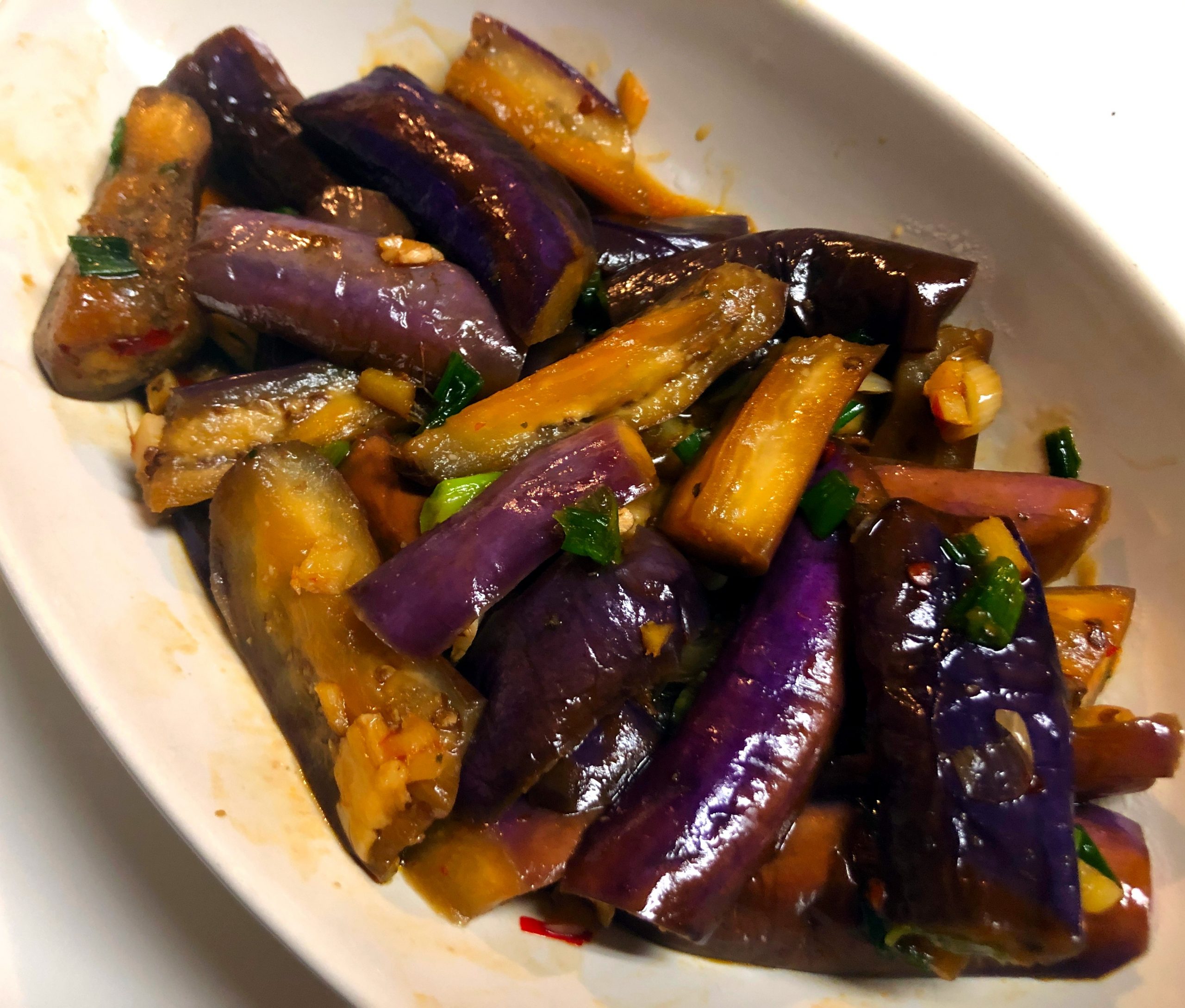
HOW TO MAKE SPICY STIR FRIED EGGPLANT
For this dish, you’ll want to use 2 to 3 long Chinese or Japanese eggplant (about 1 pound, see photo above for reference). I prefer cooking with this type of eggplant in general because the seeds are much more tender compared to larger eggplant. Plus, the eggplant usually doesn’t taste bitter.

Take the eggplant and cut them into 2.5 to 3-inch sections. Then, slice each section into batons that are about 1/4 to 1/2-inch thick.
Many eggplant recipes recommend salting the eggplant and letting it sit for a while, but I don’t think that is necessary for this recipe. The purpose of the salting is to draw out moisture from the eggplant and to mask the bitterness of eggplant. However, I don’t find Asian eggplant to be bitter. Furthermore, I don’t find the minimal amount of moisture in the eggplant to be an issue for flash frying the eggplant. Finally, whenever I salt eggplant beforehand, I lose some of the subtle, sweet flavor of eggplant, which I enjoy. The sauce in this spicy eggplant recipe is quite flavorful already! For these reasons, I don’t think you need to salt the eggplant before flash frying.

Fill a wok with 3/4 cup of canola or any neutral-flavored oil and heat it over medium-high heat. Once the oil reaches about 350ºF to 360ºF (175ºC to 180ºC), the oil is ready for frying (this should take about 3 minutes). Working in batches, fry a large handful of eggplant in the hot oil for 1 minute. Then, transfer the flash-fried eggplant to a plate and continue to flash fry the remaining eggplant.
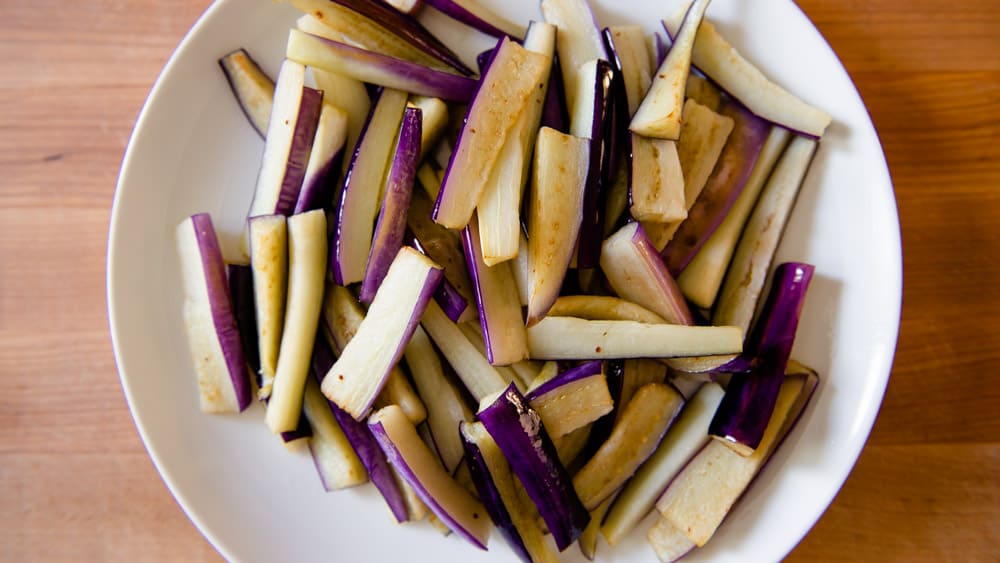
The frying process softens the eggplant without turning it grey and mushy. Plus, the frying better preserves the vibrant purple color of the eggplant skin, which makes your dish much more visually appealing.

For those of you who don’t like frying foods in a lot of oil, you can pan fry the eggplant over medium-high heat. As you can see in the photo above (left), pan frying will turn the eggplant skin brown. Another thing to note is that eggplant absorbs oil like a sponge. Even if you are pan-frying eggplant, don’t be frugal with the oil. Otherwise, the eggplant might come out a little dry.
You can also toss the eggplant with 1 1/2 to 2 tablespoons of oil and air fry at 350ºF (175ºC) for 5 to 6 minutes, giving the eggplant a shake halfway.
In the past, I have cooked eggplant with water to avoid using excessive oil. I would pan fry the eggplant with a little oil and add water once the oil has absorbed into the eggplant (see photo above, right). The problem was that the water made the eggplant grayish and a little mushy for my taste. That’s why I don’t usually cook eggplant that way anymore.
Once you have fried all the eggplant, pour all the oil into a heat-safe bowl and leave about 2 tablespoons of oil in the wok. You shouldn’t have that much oil leftover. You can use that oil to cook other dishes like Chinese stir fry shredded potatoes or egg fried rice. for up to a few days.
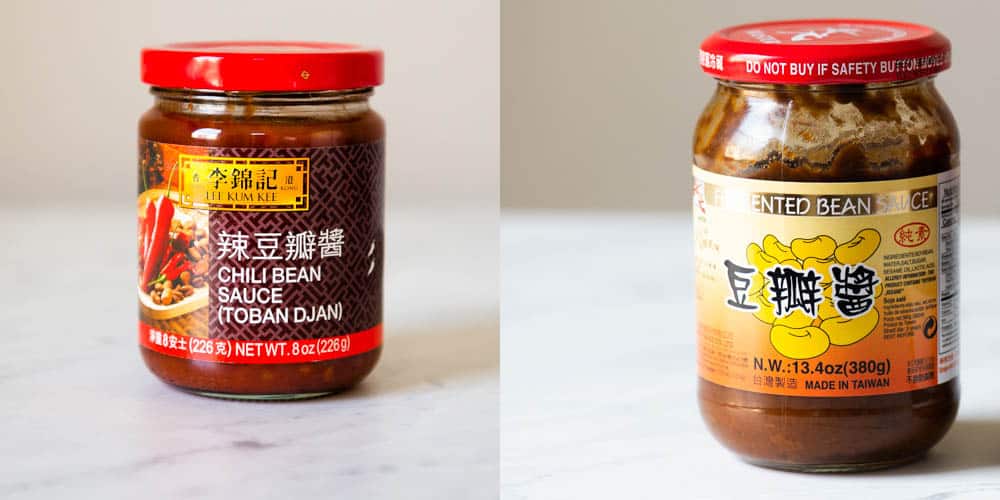
This recipe relies on doubanjiang (豆瓣酱/豆瓣醬), Sichuan-style fermented broad bean chili sauce/paste. There are many different brands of doubanjiang that you may find (see photo above). When testing this recipe, I used Lee Kum Kee’s doubanjiang, which has a redder color than the paste you see on the right. Any doubanjiang should work for this recipe. Besides this spicy eggplant recipe, you can also use doubanjiang in my vegan mapo tofu recipe.
You’ll also need some minced garlic and ginger.

I also added Sichuan peppercorn for the sauce because I like the floral notes of the peppercorn. I took 1 teaspoon of Sichuan peppercorn and ground it with a pestle and mortar, which yielded about 1/2 teaspoon ground pepper. Sichuan peppercorn is known for its tongue-numbing spice, but the amount used in this recipe wasn’t enough for me to detect a tongue-numbing sensation. You can leave out the Sichuan peppercorn if you don’t have any.
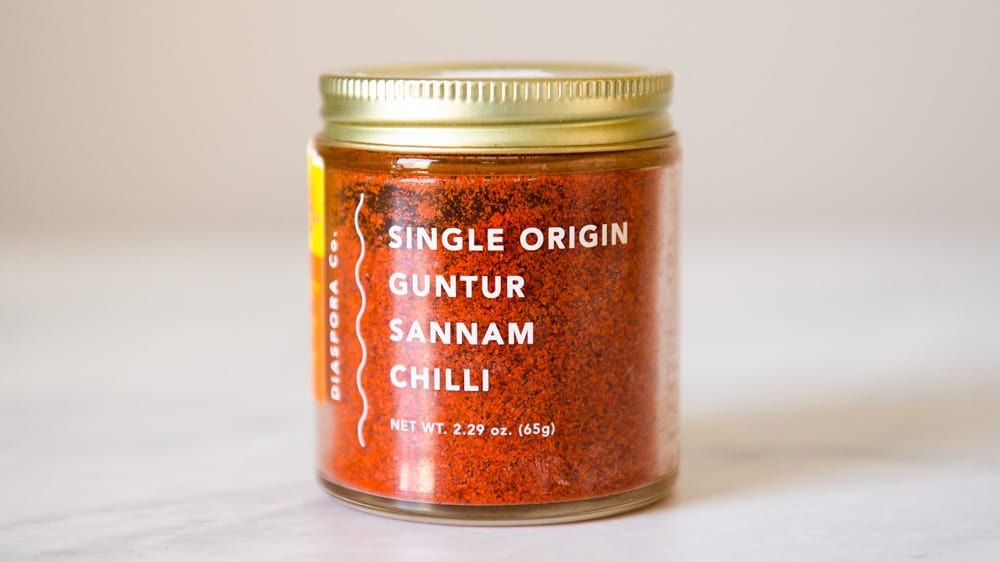
For additional spice, I also used red chili flakes from Diaspora Co. It has a medium level of spice and I love the vibrant color of the flakes. You can use gochugaru (Korean pepper flakes) or red pepper flakes (with the seeds) that you can usually find at the supermarket. The pepper flakes with the seeds tend to be made with cayenne pepper, so you might want to use less than what I specify in the recipe.
Feel free to reduce or increase the level of spice in this dish to suit your taste.
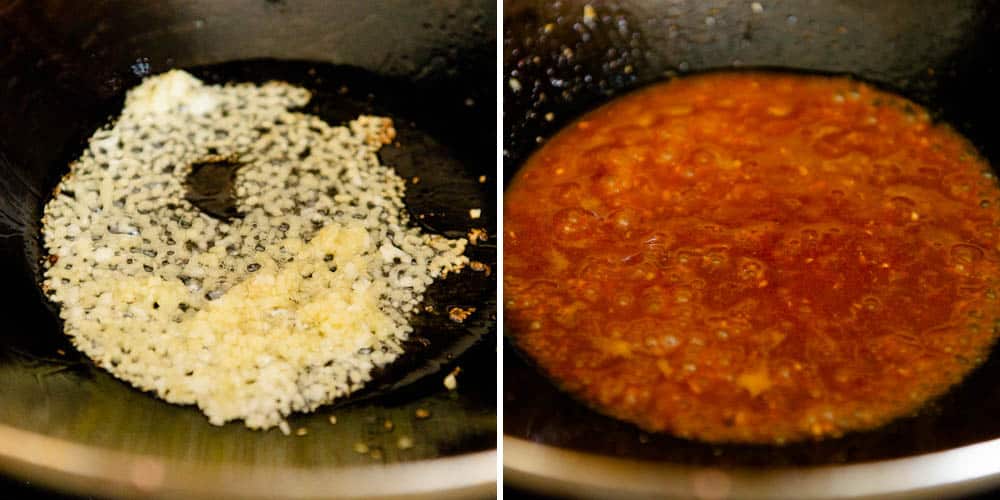
With the heat on medium-high, add the garlic and ginger to the wok. Cook for about 30 seconds, until you can start smelling the garlic. Add the doubanjiang, and cook for 30 seconds more. Next, add the ground Sichuan peppercorn (if using), chili flakes, sugar, and salt. Stir to combine.
Next, add in a cornstarch slurry (water mixed with a small amount of cornstarch) to the wok. Bring the liquid to a rapid boil and then let it simmer for 30 seconds to a minute so that the sauce can thicken.
Add the flash-fried eggplant back into the wok and stir to combine with the sauce. Transfer the eggplant to a plate. Add scallions and sesame seeds on the eggplant for garnish.
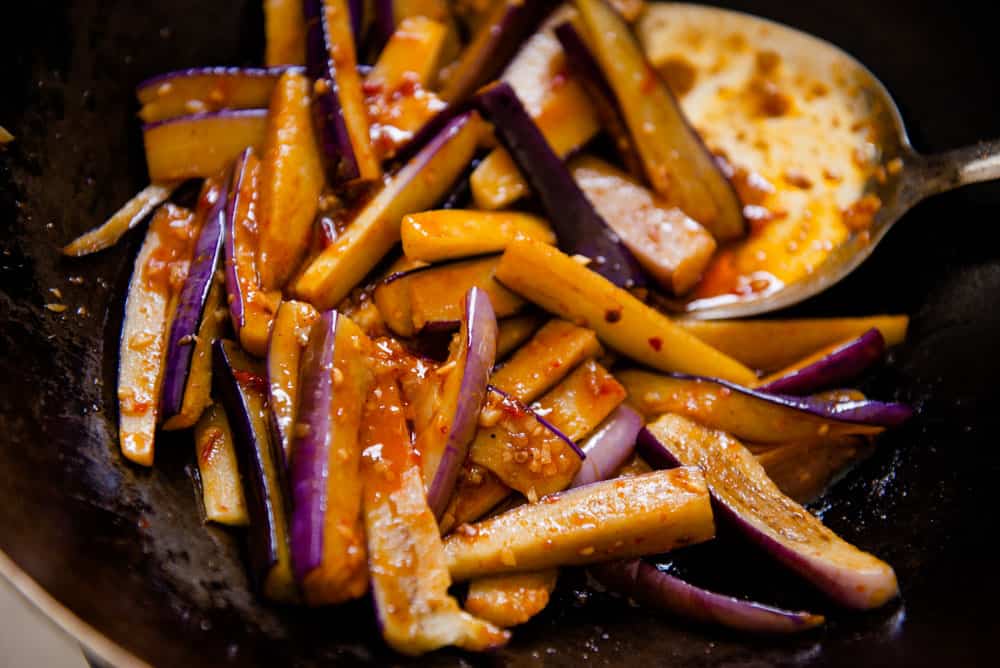

Make this restaurant-style spicy Chinese eggplant recipe at home | Marion’s Kitchen
FAQ
Is eggplant supposed to taste spicy?
Why does my mouth tingle when I eat eggplant?
Is raw eggplant spicy?
Why does eggplant upset my stomach?
What does eggplant taste like?
Sometimes referred to as Chinese eggplant or Asian eggplant, this type of eggplant is usually long and slender with tender purple skin and sweet, meaty flesh. They have fewer seeds than rounder varieties, which gives them a nice, firm texture and a less bitter flavor.
How can one use eggplant?
Some ways to enjoy eggplant are: in a curry, stir-fry, as Babaganoush, with pasta, eggplant pizza, breaded and baked, as eggplant lasagna.
Does eggplant taste bitter?
Plus, the eggplant usually doesn’t taste bitter. Take the eggplant and cut them into 2.5 to 3-inch sections. Then, slice each section into batons that are about 1/4 to 1/2-inch thick. Many eggplant recipes recommend salting the eggplant and letting it sit for a while, but I don’t think that is necessary for this recipe.
What is Chinese spicy garlic eggplant?
Tender eggplant cooked in a spicy, savoury garlic sauce fried with aromatic dried red chilies, green onions, and ginger. This delicious Chinese eggplant recipe is ready in 30 minutes. Great as a side dish or as a main course. Other Chinese recipes you may like!
